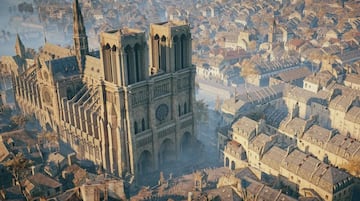Interview
Assassin's Creed Unity and Notre-Dame: a strong digital connection
After 5 years of restoration, Notre-Dame de Paris opens its doors next week, but we will always be able to visit it virtually.

On April 15, 2019, one of France’s most iconic historical monuments suffered a terrible accident. The Notre-Dame de Paris Cathedral caught fire and suffered significant damage, destroying two-thirds of its roof and damaging its signature central spire. The cathedral will reopen its doors to millions of worshippers and tourists on December 7, five years after work began.
But what does this have to do with the world of video games? Five years before the tragedy, Ubisoft released Assassin’s Creed Unity, one of the most impressive works of this console generation. The game recreated Paris at a magnificent architectural and visual level during one of the most influential moments in modern history: the French Revolution. With such an incredibly detailed Notre-Dame de Paris Cathedral, it was considered at the time as a possible basis for the reconstruction of the original building after the tragedy.
As part of the celebrations for the upcoming reopening of this monument, we had the opportunity to speak with Maxime Durand, World Building Director at Ubisoft, who talked to us about the challenges of bringing this monument into the video game and all the little details about why this digitalization couldn’t bring something back to the real world.
The differences between the real and the virtual
One of the first details we talked to Maxime about was the clear differences they had to work with when digitizing the 21st century Notre Dame to bring it into the 18th century. He told us that “what we did was to understand the whole history of the monument from the 21st century and then adapt it to the needs of the game. It is not totally a faithful reproduction, but it’s a version that is credible. The way we built it for Assassin’s Creed Unity was by researching historical references. The history of the monument itself from its creation until the 18th century, how it was different during the French Revolution. It was also important to know that after the revolution it fell into decay; the Spire was gone, for instance, is one of the most iconic elements that big element that caught fire in 2019.”
Another concern we had was whether the AC Unity version somehow saved something that is no longer in the real version. To this, Maxime replied with an important explanation of how the digitization work on the cathedral did not contribute to its reconstruction: “We recreated the monument with artifacts and photos, so we don’t need the real [complete] monument. We didn’t show all aspects of the monument with precise details, so it’s hard to say if there were things that were lost that made an appearance in the game.”

In addition to this, Maxime also commented that there are some interesting changes in this digital version. Although the team took great care to make it 100% real and historical, there are some details. “As a historian, there is always a challenge between how people perceive it now and how it was before. Historically, sometimes there are differences, so you have to find that balance. In the case of Notre Dame, the most concrete example is the gargoyles that were added in the 19th century, as well as the new spire. In the game, the spire we have is from 1860, by Viollet-le-Duc. We tested with players when we made the game with the monument without the spire to see if they would recognize it, and they did not. Because it’s such an iconic thing, and it’s the highest point on the Unity map, we decided to keep it, even though it wasn’t the most historically accurate.
Assassin’s Creed Unity was released on November 11, 2014, for PlayStation 4, Xbox One and PC and received a score of 72 on Metacritic. For its part, Ubisoft donated 500,000 euros to the reconstruction of Notre-Dame de Paris.